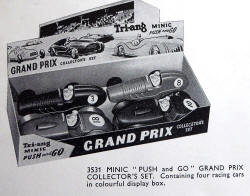The latest addition to my Minic collection a
1/32 scale approximately, Ford Monarch/Tudor Sedan in blue plastic.
Originally marketed under the Penguin brand with a rubber band drive,
later models had a clockwork motor.
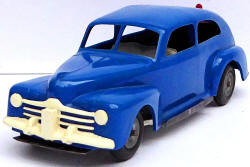
My posting earlier showing my latest addition to
the plastic Minic’s seemed to create a fair amount of interest so have
decided to share with you some more of the larger scale models from my
collection.
The first one I will mention is the Ford 100e
Squire as it does not appear to have been documented in my Tri-ang Minic
catalogues or in Sue Richardson book on the same subject. The real thing
was produced as part of the Prefect range from 1955 until 1959 so surely
this means it was produced by Tri-ang within this time scale. The early
models came with the “woody effect” so this must be based on the later
examples, some of which were called “Escorts” which had a cheaper
specification and no chrome, so hence the simplified grill and these
were produced until 1961. The model is 5 inches long and has a Push & Go
motor on the rear wheels, with some rudimentary steering on the front
wheels, it is most often seen in red plastic, but I have also seen a
blue plastic version.
Next comes the No 2 Musical Car 205M which has a
wind-up clockwork motor and a built-in musical box which plays as the
car goes along, it is 7 inches long with steerable front wheels.
The blue open Sports Car is a Jaguar XK120 the
early models had a clockwork motor, but this example with the Push & Go
type motor still has the keyhole in the nearside mudguard. Both versions
may well have come with a separate lift off hood which always seems to
be missing from unboxed models.
The green car is a Riley Saloon with a wind-up
clockwork motor with what I believe is a brake which is shown just below
the front bumper, there is also a police car version.
The red car is 3128 a Push & Go Armstrong
Siddeley, again this was originally with a clockwork motor as can be
seen from the keyhole in the rear offside, just behind the door.
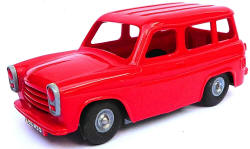
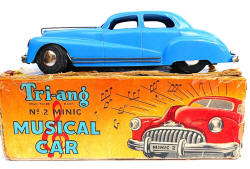
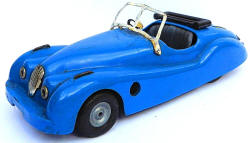
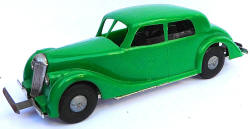

I will now share with you a few more of the
larger Minic Push & Go models. These models were described as being the
OO range which would suggest being suitable for 1/76 scale, but they are
however much closer to 1/32. The OOO range are the ones suitable for
OO/HO gauge 1/76 railways, which causes much confusion for some
modellers. At first these models had an “M” prefix in line with the
earlier tinplate models, but by 1957 these had been changed to a
four-figure number only reference.
The FX3 Taxi is model number 3181 but is also
shown in the same catalogue as London Taxi 3459 and the only visible
difference is chrome hubcaps to the wheels, I have this model in red,
yellow and white plastic and do believe it also exist in green and blue
plastic but for some reason it was never seems to have been produced in
the iconic black plastic.
The LCC ambulance is model number 3129 and is
based on the 1949 Daimler model of which 499 were built with a top speed
of 75mph, I have only ever seen this model produced in the creamy white
plastic.
The Delivery Van is model number 3182 and
appears to be generic, but some lines from classic vehicles is
recognisable. It usually comes with the transfer as depicted on the red
model, the transfer on the blue model was almost totally gone and I made
a suitable replacement. It is quite likely that this model also exist in
other colours of plastic.
The final model in this posting is the 3177
Petrol Tanker, based on a forward control vehicle of a generic type. It
generally comes with the Fuel Oil transfer which seems to have been well
used by Tri-ang. It was in first use as long ago as 1936 when it was
part of a longer item reading “Shell BP Fuel Oil” used on the
articulated tinplate petrol tanker. It has obviously been shortened for
use on this model whilst other parts of this transfer can be found on
other models including the rubber oil tank in the Tri-ang Railways range
and the smaller OOO range of Push & Go vehicles suitable for use with
the OO/HO railways range. The yellow plastic coloured model with Shell
transfer appears to have been an export model for north America as it
seldom turns up here in the UK
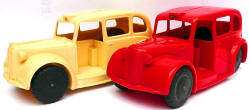
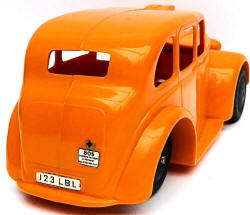
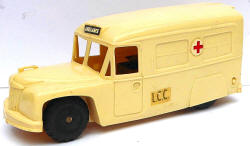
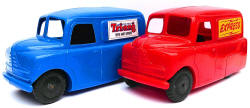

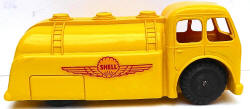
I am continuing the sharing of the Tri-ang Minic
Push & Go models with their versions of Grand Prix and Le Mans cars. All
these models date from the early to mid-1950s and are made in acetate
and very prone to “age related” warping. As far as scale goes, they are
quite similar in size to the early Scalextric models so somewhere around
1/32 scale.
The first two pictures are of the catalogue
number 3112 Ferrar Racing Car, which I have in red, green, blue and
white plastic, the model is 4 inches (about 10cm) long and has “Tri-ang”
under the exhaust on the offside rear and “Made in England” on the
nearside. It has a separate driver and clear cellophane windshield that
is only present on the red model, and this appears to be the most common
of the 4 models shown.
The other 3 models are collectively known as “Le
Mans Racers” and are catalogue number 3111 but you will see they are all
different mouldings. Tri-ang did not bother to identify any specific
car, but if you look closely, you will see they have characteristics
normally associated with the makes of Jaguars, Porsches, Mercedes,
Ferrari and others, perhaps one of our motor sport experts would like to
speculate on the particular model that the Tri-ang designers had in
mind. The bulges on the bonnets of the red and green models is to
accommodate the flywheel of the friction motor that is located on the
front axle, whilst the blue one has rear wheel drive and the flywheel is
below the hump behind the drivers head.
My final picture is taken from the 1957
catalogue and is catalogue number 3531 the “Grand Prix Collector’s Set”
two of which are the Ferrari, whilst the other two are obviously the Le
Mans cars, Tri-ang was not always consistent with their accuracy on
descriptions. Like most of the other models in the Minic Push & Go
series by the end of the 1950s they had been phased out, but stock may
have remained on warehouse or shop shelves for a few years, I have said
earlier that I was still finding these models as new in the early 1970s.
It’s worth noting that the blue and green Le
Mans cars both have “made in England & New Zealand” on the base so were
obviously available for export.



